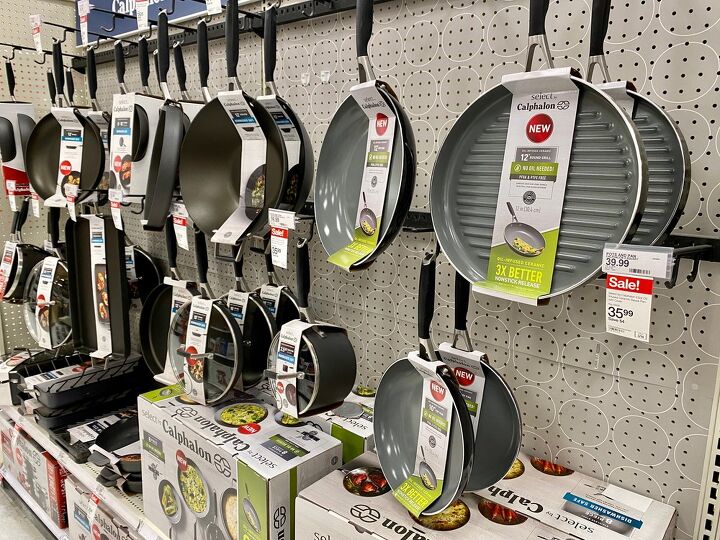How To Restore Calphalon Pots And Pans (3 Ways To Do It!)

Known for their nonstick nature, high-performance Calphalon cookware can be a lifesaver in the kitchen. However, after the meal has been completed, they need to be properly cared for in order to ensure they are long-lasting and stay in their best condition. This is especially the case if you’ve burnt your food and your Calphalon pots and pans may require some restoring.
Calphalon makes a number of bakeware and cookware products. From nonstick and stainless steel to hard-anodized aluminum, each Calphalon product needs to be cared for in different ways. For example, while stainless steel and hard-anodized aluminum are relatively forgiving when exposed to high temperatures, nonstick will not react well to heat above 400 degrees.
If you’ve had a disaster in the kitchen and your Calphalon cookware appears beyond saving, there are multiple methods you can implement to restore them. For minor staining, you should just be able to scrub with a mild dishwashing liquid, while tougher stains may require the use of vinegar, baking soda, or specialized cleaning products. We’ve assembled everything you need to know about restoring and maintaining your Calphalon pots and pans.
Method #1: Hand Washing Your Calphalon Pots and Pans
Most Calphalon nonstick cookware is not dishwasher safe and should, instead, be washed by hand. If you have staining or burns on your pots or pans, using a mild dishwashing liquid is the first choice to remedy the mess. As long as the cookware isn’t completely ruined, this method is ideal. However, it is not like traditional dishwashing.
Follow these steps to restore your Calphalon pots and pans by hand washing them:
- Rinse with warm water. Begin by rinsing the dirty pots and pans under warm water. Both the heat and pressure will help to loosen up any stuck-on food particles that are gripping the surface of the cookware. Before proceeding, try to dislodge as much of the food as possible.
Quick Tip: Avoid using cold water on Calphalon cookware, as it can lower the temperature of the cooking surface too quickly and may cause it to warp or weaken.
- Wash the surface by hand. Although there are some Calphalon cookware that is dishwasher safe, hand washing will help to preserve the finish and sheen. It also allows you to provide a more delicate treatment and spot clean the surface effectively.
- Soak stubborn stains. If you have any especially burnt or stuck-on food residue, it may require some additional treatment. In this case, soaking anodized aluminum cookware will help release hardened particles without the need for abrasive scouring. Fill the pot or pan with hot water and allow it to sit for 10-15 minutes. Follow up by hand washing as normal.
- Use mild liquid detergent and a non-abrasive sponge. After you’ve dislodged as much as you can by using warm water, your hands, and soaking, you’ll want to start implementing the dish soap. Choose a mild liquid dish soap such as Palmolive or Dawn. Avoid using anything that contains harsh chemicals or caustic agents, as they may cause scratches on the surface. Scrub the surface using a soft-bristled brush, non-abrasive sponge, or washcloth for a soft touch. Steer clear of steel wool, or anything that could damage the finish.
- Rinse the cookware thoroughly. After soaking and scrubbing, rinse away all traces of food and soap. If either of these substances remain on the surface they will create an unsightly film when they dry. Then, shake off excess water and place the cookware in a good spot to air dry.
- Allow the pot or pan to dry completely. You can either let lay the cookware upside down to air dry or pat it dry with a clean, absorbent cloth. Keep it in a well-ventilated space to speed the drying process along. Afterward, your Calphalon should appear good as new!
Never put your wet pots or pans away with the lids on, as this can cause them to give off an unpleasant odor.
Method #2: Using Vinegar to Restore Calphalon Pots and Pans
For best results at restoring your burnt or stained Calphalon, use distilled white vinegar. The acidic nature of the vinegar will react with the scorched layer on your pots and pans, forcing it to break free from the cooking surface. Then, all you’ll need to do is simply rinse it off and it will restore the shine. If you don’t have white vinegar readily on hand, you can substitute for apple cider vinegar or lemon juice (fresh or bottled).
- Pour white vinegar into your cookware. Add about a cup of distilled white vinegar to the bottom of your soiled pots and pans. Then, fill the rest of it up with distilled water.
- Soak your Calphalon. Allow the mixture to soak for about 10-15 minutes before proceeding. After only a brief amount of time, the stuck-on residue will start to break away from the surface.
- Dump the dirty mixture down the sink and scrub. After the recommended amount of time is up, dump the dirty vinegar water down the drain. Then, gently scrub any trace of the food with a mild dishwashing liquid and non-abrasive sponge. As you’re scrubbing the surface, make sure to remove off all of the buildup.
- Thoroughly rinse the cooking surface and let dry. Make sure that your cookware is rinsed completely and either pat dry or let it air dry before putting it away.
Alternatively, you can fill the damaged pot or pan with ½ cup of white vinegar and equal parts water. Then, place the Calphalon onto a stove at medium-high heat for roughly 15 minutes. The exposure to heat will help to loosen the burnt residue from the surface much faster.
Method #3: Using Baking Soda to Restore Calphalon Pots and Pans
A mixture of warm water and baking soda can also help to restore your Calphalon cookware. This mild alkali will react with the stained surface and cause the residue to break away from the surface. Though it may take slightly longer than other methods, it is just as effective.
- Mix together a solution of baking soda and warm water. Mix a few teaspoons of baking soda with warm water and pour it into the damaged Calphalon.
- Let the Calphalon soak. Allow the cookware to soak for a few hours, two hours being the max.
- Scrub the affected area. After the mixture has soaked for long enough, scrub the surface with a non-abrasive sponge. Work gently to avoid causing any scuff marks and scratches to the cookware.
- Drain the baking soda solution and repeat. Drain the mixture into the sink and repeat the above steps until you start to see residue floating in the solution. This indicates that the baking soda is reacting with the burnt layer.
- Clean and dry the cookware. Once you’ve soaked the cookware multiple times, clean any remaining stuck-on food with a good scrub and allow it to dry completely.
Avoid using too much baking soda for this method, as it can be a caustic substance. When exposed to excessive baking soda, your Calphalon cookware can start to corrode.
Caring For Calphalon Cookware
By caring for your Calphalon pots and pans appropriately, you will ensure that it can provide you with an unmatched cooking experience for years to come. The following are some tips and tricks to properly care for your Calphalon cookware.
- Let the cooking surface cool completely before washing it. Allow it to return to normal temperature first. Also, only use warm or hot water when cleaning.
- Although Calphalon is known to be scratch-resistant, too much wear and tear can destroy the nonstick finish. Avoid being too rough with your pots and pans and they’ll be guaranteed to last you a long time.
- If your cookware begins to look dull after repeated use, polish it with a special cleaner such as Bar Keepers Friend or Calphalon Dormond Cleanser. These types of cleansers are specially formulated to use on stainless steel and various other nonstick surfaces. Using them properly will help to renew the shine and smoothness of your Calphalon.
- Avoid using harsh chemicals on your pots and pans. Use only mild dishwashing liquid and those that are specialized for use on Calphalon. Those with toxins can cause the Calphalon surface to corrode.
There’s no need to be disheartened when you experience a cooking mishap with your Calphalon pots and pans. Whether you use baking soda, vinegar, or mild dishwashing liquid, there are several ways to restore your Calphalon cookware.

Jessica considers herself a home improvement and design enthusiast. She grew up surrounded by constant home improvement projects and owes most of what she knows to helping her dad renovate her childhood home. Being a Los Angeles resident, Jessica spends a lot of her time looking for her next DIY project and sharing her love for home design.
More by Jessica Stone













![The 5 Best Angle Grinders – [2022 Reviews & Buyer's Guide]](https://cdn-fastly.upgradedhome.com/media/2023/07/31/9071326/the-5-best-angle-grinders-2022-reviews-buyer-s-guide.jpg?size=350x220)
![10 Best Electric Lawn Mowers - [2022 Reviews & Top Rated Models]](https://cdn-fastly.upgradedhome.com/media/2023/07/31/9070486/10-best-electric-lawn-mowers-2022-reviews-top-rated-models.jpg?size=350x220)












